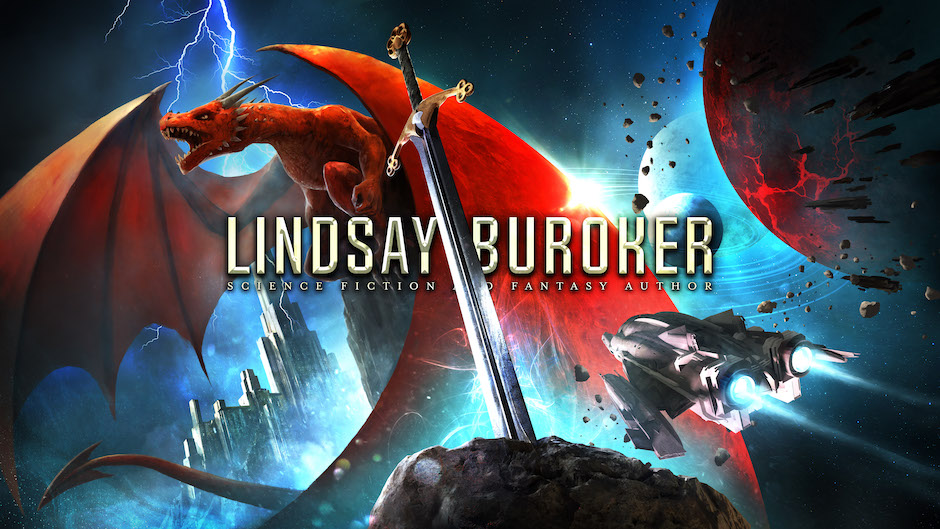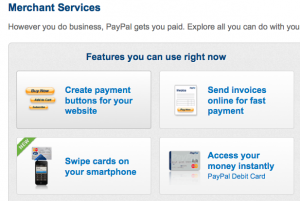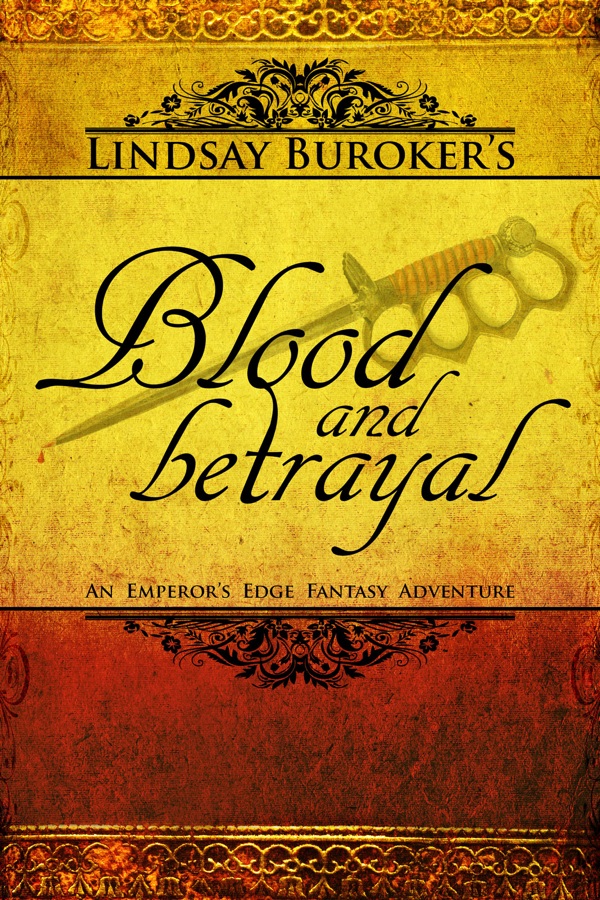I thought I’d take a break from the self-publishing theme today and share some news about what’s coming up next with Encrypted, the EE series, and other projects. This is the first of two posts where I answer reader questions (a thank you to the ladies — and Andre! — over at the EE forum for posting them for me) and chime in on fan fiction, characters on Twitter, and other terribly important topics. 😉
Moondreamer asks, “What’s the timeline for Decrypted? Will it happen soon after Encrypted, a few years afterward? A long time?”
Decrypted will take place shortly after the first novel. I’m finishing up a Tikaya-and-Rias short story right now (tentatively called Enigma) that takes place on the journey back to the Kyatt Islands. Decrypted will start with them pulling into Tikaya’s home port where Rias will be about as welcome as a toe fungus.
There’ll be the family and government to deal with along with a new mystery to solve. And, because we haven’t had nearly enough underwater adventures (maybe I’m planning to be the first big oceanpunk author?), Rias may be building the first submarine to mix Kyattese Science with Turgonian engineering.
MaggieJ asks, “Are there going to be anymore EE stories after EE6 or is that one going to end it?”
Assuming I can actually manage to end the current story arc and wrap up everything in Book 6? 😉 I do have some ideas for future adventures (more on a possible EE7 below), but I’ll probably take a break to work on something else and also see what the interest level is amongst readers.
Meera asks, “This is kind of along the same lines: Any more books in that universe, or do you want to start somewhere else? Will you write more in the Flash Gold Chronicles after EE6 (7?) is out?”
I do want to start a new series at some point, though that doesn’t necessarily mean abandoning the gang forever. I definitely want to write a couple more Flash Gold stories and bring some closure to those characters. I’ve even kicked around the idea of getting Kali and Cedar onto their airship and out of the Yukon as a jumping off point for a whole new series. Of course, there are other projects in the holding pattern too. I need to learn to write faster so I can implement all of my ideas sooner!
Mana asks, “What’s it feel like to have fan fiction/art/twitter characters all over the place? Is it an author dream come true or an “oh dear god don’t they have a life” type of thing? Rabid fans want to know…”
It’s really cool! It’s been very rewarding to see that the characters resonate with people and that they want to spend more time with Maldynado, Amaranthe, and even Sicarius (it’s amazing how many readers are interested in the inner life of such a stiff, unfriendly sort of assassin!). It’s also cool to see that a community has grown up where people who probably wouldn’t have ever met otherwise are now online buddies. Maybe we’ll all meet up at a con someday. Some have even proposed a pool party at my house (they don’t seem to mind that I don’t actually have a pool and can only offer a Slip ‘n’ Slide and a horseshoe pit).
Exstock asks a pile of questions, starting with… “–I second the “more EE after EE6?” question! So one arc is done; I’m sure plenty of us would be happy with the start of a new arc.  Will Sespian get a love interest in said hypothetical books? Will Yara get a POV? And what is Sicarius’s internal reaction when someone swears by the Emperor’s ancestors? Seeing as, you know, he actually is one.”
Will Sespian get a love interest in said hypothetical books? Will Yara get a POV? And what is Sicarius’s internal reaction when someone swears by the Emperor’s ancestors? Seeing as, you know, he actually is one.”
You mean a love interest other than the one he already has? 😉 There may be something floating around in the back of my mind…
I haven’t thought much about doing a completely new story arc yet, but I do have some ideas for an EE7 that would wrap up a lot of the relationship threads (and there’s always the idea of a quest for someone’s unidentified parents…) that probably won’t have time to find closure in EE6. I see that story as perhaps being the first book to have more than two POV characters. In that case, we might get into Yara’s head. We’ll see! I have to figure out where everything is going to end in 6 first.
As for whether Sicarius has a reaction to someone cursing the emperor’s ancestors, I imagine he might note it, once in a while, in that dry way of his, but I suspect it’s like most of our curses where we just spit them out and nobody thinks much about what they mean.
Andre Dias asks, “- What’s the biggest sense of accomplishment with EE? – Which character do you feel a stronger bond with, if you make distinctions regarding them. Or do you love them equally?”
Well, finishing that first book was a pretty big milestone for me! Now I’d say that I get the biggest kick out of hearing from readers and seeing how much people are enjoying the story and characters. So the biggest sense of accomplishment may just be in having created a world and characters that many readers are passionate about.
As far as favorite characters go, it’s usually certain pairings that I enjoy writing because of the way they interact with each other. I’m sure it’s no surprise that I love writing dialogue, and that’s not something you get to do a lot of when the hero wanders off alone. For pairings, Maldynado and Books are always fun because of their contrasts (and now Maldynado and Yara too). And, of course I like writing Amaranthe and Sicarius too. What’s not to love about stony glares, one-syllable answers, and a monochromatic wardrobe?
Kitty asks, “Will there be more short stories of the EE Team? Have you got another universe in mind for new stories? When is book 6 out? ;)”
I haven’t started writing 6 yet, so no idea for a date yet. I’ll see how long it takes me to do Decrypted (I’m shooting for about January for that one.)
I have a couple of new series ideas, and I’m not sure which one I’ll do next. I have a globe-trotting urban fantasy in mind, a steampunk/dystopian world, and I still want to get back to my Goblin Brothers heroes and publish their first novel. GB1 is already in draft form on my hard drive somewhere. I just haven’t polished it up because middle-grade fiction is a pretty tough sell in ebook format.
Right now, though, I’m just focusing on these next two books. And whatever short stories demand to be told in the interim (look for Enigma in October some time!).
Hm, I have more questions here, but I’m going to answer them in a later post. Thanks for reading, all!
Update: the second Q&A around is up.


 I wrote up a blog post, announcing the availability of the eARC and letting folks know what they’d get and how long the offer was available (it’s always a good idea to put a time limit on these sorts of things, so people, if they’re interested, are less likely to put off buying until “later” and then forget). Then I headed to my Paypal account and clicked the “Merchant Services” tab. I selected the “create payment buttons for your website” link and filled out a three-part form. They gave me the code, and I stuck it at the end of the blog post. Overall, it took less than 10 minutes to go from, “I wonder how I go about doing this” to having the Paypal button in the post.
I wrote up a blog post, announcing the availability of the eARC and letting folks know what they’d get and how long the offer was available (it’s always a good idea to put a time limit on these sorts of things, so people, if they’re interested, are less likely to put off buying until “later” and then forget). Then I headed to my Paypal account and clicked the “Merchant Services” tab. I selected the “create payment buttons for your website” link and filled out a three-part form. They gave me the code, and I stuck it at the end of the blog post. Overall, it took less than 10 minutes to go from, “I wonder how I go about doing this” to having the Paypal button in the post.





